“Broadsword Calling Danny Boy”
|
Read more
at in70mm.com The 70mm Newsletter |
| Written and photographed by: Thomas Hauerslev | Date: 11.04.2009 |
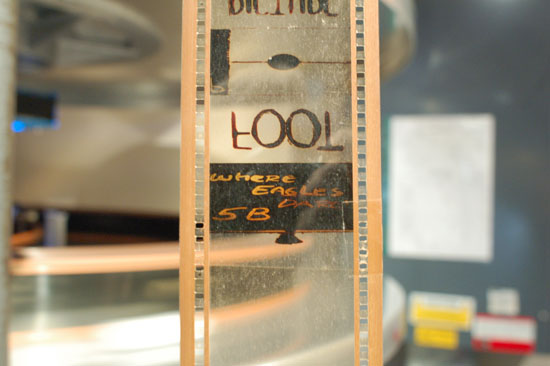 Prepared for a weekend in 70mm? Prepared for a weekend in 70mm?Let’s start with the end. We said all the “goodbyes” and "see you next year" on Monday, March 23 around 15:00, following “double Bill”, a phrase I coined in 2008 in honor of Bill Lawrence's work for the Widescreen Weekend since 1996. Some would be going home to Australia, some to France, some to Germany, Sweden, USA, Holland, Denmark, Switzerland, Canada, New Zealand, Italy, Czech Republic and let's not forget the United Kingdom! After 4 days of “widescreen” it's possible many would be suffering from weekend fatigue. But what makes people fly in from all over the world to spend a “Widescreen Weekend” in Bradford and seeing films, which are sometimes faded and in most cases very, very old? The reason? Well, the best cinema in Britain of course, the Pictureville - sometimes lovingly referred to as “Nerdville”, in beautiful, West Yorkshire, England. About 150-200 people meet annually in March to see some different films from a different time presented very differently compared to what modern cinemas are doing. “In Cinerama” and “in 70mm” are unfamiliar ways of cinema presentation to most contemporary audiences. But for this fairly small international group of people, they are household names. In this collection of notes I will try to describe a few highlights from the 2009 festival and give a few personal observations. |
More
in 70mm reading: Widescreen Weekend 2009 • Gallery: 2009 • WSW Home • Through the Years • The Best of WSW • Academy of the WSW • Creating the WSW • Planning the WSW • Projecting the WSW • Home of CINERAMA • Projecting CINERAMA Lost Orphaned Films Abandoned in Basement The History of 70mm Short Subjects |
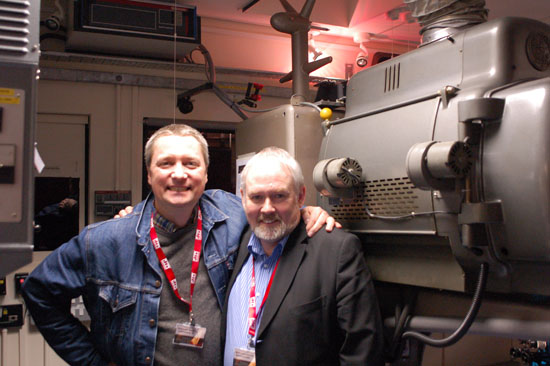 Thomas and Bill - 70mm brothers separated by country and beauty. Thomas and Bill - 70mm brothers separated by country and beauty. My own personal 14th visit began on the Friday, March 19, 4 days earlier, and the visit was the culmination of 6-7 months of work, planning the program - which included editing the official "un-official" web site. And while I am thinking about it, many thanks to Sheldon and Wolfram, who have been doing a splendid job making sure my details are correct on the festival page. I was about to land in Manchester (UK) airport. Suddenly, there was a hole in the clouds and I could see houses, a golf course and roads. The cars were going in the “wrong” direction: Yes, there is no doubt, this is England! The plane was shaking when it went through the clouds and it seemed as if the Airbus 321’s engines were running in idle. The sun was shining and I looked forward to get my feet on the ground. Minutes later the big airplane landed gracefully and I was pushed forward against the seatbelt restraint when the brakes were activated. It was 9:15 local time and I hoped I would be able to get the 10:05 train to Leeds. |
Film Introductions: "The Bible...in the beginning" "How the West Was Won" "Khartoum" "The King and I" "This is New Zealand" "West Side Story" "Faubourg 36" 70mm in Paris "This is New Zealand" 3-strip EXPO Film From New Zealand The M.C.S.-70 Process The Reconstruction and Restoration of John Wayne's "The Alamo" |
 The world's best audience The world's best audienceEverything went well, and sooner than I expected I was checking in at the Midland Hotel in Bradford. It’s a classic old railway hotel, and one of the official sponsors of the Bradford Film Festival. I was looking forward to seeing many friends who I have come to know over the years: Ben Eagle, Bill Lawrence, Paul Rayton, Duncan McGregor, Tony Cutts, Malcolm Clarke, Francois Carrin, Tony Earnshaw, Deb Singleton, Dave Strohmaier, Randy Gitsch, Tom March, Jakub Klima, Peter Andren, Brian Guckian, Clemens Sherer, Andrew King and many, many more. The list is very long. As Bill likes to say, “it is my second family”, the WIDESCREENERS. Many are on a first name basis and only see each other this one time every year. The first hours are spent saying hello to many guests and museum staff, and listening to their expectations and what they look forward to seeing. Having been involved with the planning for many years, it is always exciting for me to learn if the final program will be as interesting for the guests as I think it is. |
|
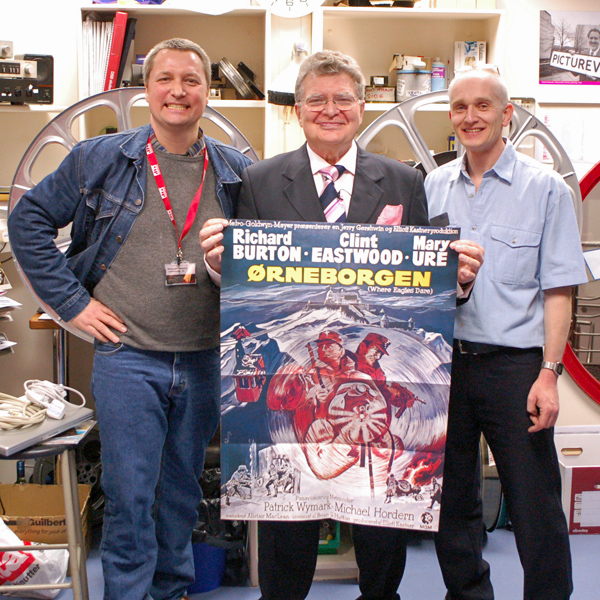 Derren Nesbitt
with Thomas Hauerslev (left) and Duncan McGregor (Right) and the Danish
"Where Eagles Dare poster in Bradford, 2009.
Picture: Thomas Hauerslev Derren Nesbitt
with Thomas Hauerslev (left) and Duncan McGregor (Right) and the Danish
"Where Eagles Dare poster in Bradford, 2009.
Picture: Thomas HauerslevAfter the Todd-AO anniversary weekend in 2005, many came up to me and said it was a fantastic program and would be hard to match. Bill and I deliberately toned down the expectations the following year, but people were equally excited. So where do we go from there? It is always a balance between what is available and what do I find interesting. That is the starting point. This year I looked forward to seeing "Faubourg 36", "Where Eagles Dare", "How the West Was Won" and “Becket”. |
|
But what is Widescreen Weekend and 70mm? |
|
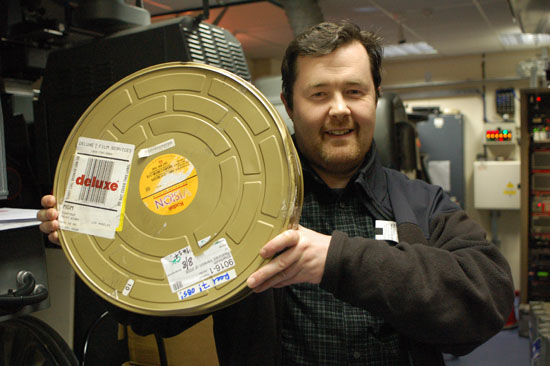 Brian Guckian (right) and a 70mm can. He's 65/70mm Workshop manager on in70mm.com Brian Guckian (right) and a 70mm can. He's 65/70mm Workshop manager on in70mm.comFor the reader totally unaware of WSW, it started as a test in October 1993 and March 1995, until it became fully organized in 1996 as a part of Bradford International Film Festival (BIFF). The WSW is 4+ days of classics in 70mm and Cinerama and widescreen in general. Strictly speaking it is not a 70mm festival, but large format is preferred by the audience and films are often presented in 70mm. Almost 15 years later it is considered as the "Mother" of all 70mm festivals. The popularity can be attributed to the work and vision of Bill Lawrence, former Head of Film and his staff's enthusiasm. The guests are exceptionally faithful. Some have attended since the first festival in 1996 and they return every year, again and again, more excited than the previous year. For outsiders, the audience (who applaud the end titles of films) can appear a little nerdish, but they are insiders, people who are highly specialized enthusiasts of big screen exhibition and their expert knowledge is outstanding. |
April 11, 2009 Dear Paul A brilliant article! Thanks very much. Thomas and yourself have a great talent for writing! Very witty and intelligent, and indeed creative. It is as always (and like the Berlin report) just like being there! I also liked the "reverse view" used in the article, starting at the end and working back. Many thanks again - and Happy Easter! Brian Guckian, Dublin, Ireland 25.03.2009 Dear Thomas Another fantastic WW comes to a close and many thanks again for all your hard work in making it happen. It's easy to think it all just magically happens, when in fact there is obviously much (Viking?) blood, sweat and tears behind it all. Every year there is something new and extraordinary to see and the WW never fails to uplift and inspire! Next stop Copenhagen! Brian Guckian, Dublin, Ireland |
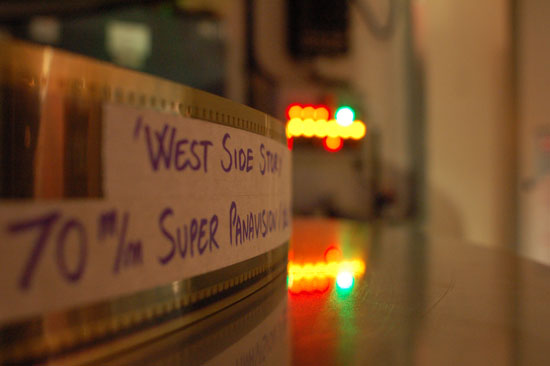 "70mm", a large format film system which guarantees superb image quality, was very popular for 15
years between 1955 and 1970, during which time it was used to film the biggest blockbusters in
Hollywood. The 70mm system was still used for its superior projection characteristics until 1992 when it vanished almost
overnight when digital sound arrived. The Widescreen Weekend celebrates
those films, by presenting these films in their original versions on the big
screen, accompanied by multichannel sound. We see them as close as
possible to how they were shown during original release - on the BIG
screen in 70mm and 6-track stereo. "70mm", a large format film system which guarantees superb image quality, was very popular for 15
years between 1955 and 1970, during which time it was used to film the biggest blockbusters in
Hollywood. The 70mm system was still used for its superior projection characteristics until 1992 when it vanished almost
overnight when digital sound arrived. The Widescreen Weekend celebrates
those films, by presenting these films in their original versions on the big
screen, accompanied by multichannel sound. We see them as close as
possible to how they were shown during original release - on the BIG
screen in 70mm and 6-track stereo. |
17. April 2009 Dear Thomas A brilliant article! Thanks very much. Very witty and intelligent, and indeed creative. I liked the "reverse view" used in the article, starting at the end and working back! "Broadsword Calling Danny Boy" was also very clever. Many thanks again for an in-depth run-down...those who weren't there could almost feel they were! Cheers Brian Guckian, Dublin, Ireland |
Odd reels, RAMAs and "Cineramacana" |
|
 A "lost" film on the curve. Bob Gaffney's "Bridge to Space" for NASA. A "lost" film on the curve. Bob Gaffney's "Bridge to Space" for NASA.Among my favourites during the WSW are the short films, odd reels, forgotten trailers, orphan main titles, etc, etc. All sorts of clips of motion picture film which have been set aside in basements, attics and cupboards. Sometimes they are found. Sometimes they are brought to Pictureville to be projected on the the silver screen one last time. That's what "Cineramacana" - a term coined by Bill Lawrence - is all about. Another inspired moment. |
|
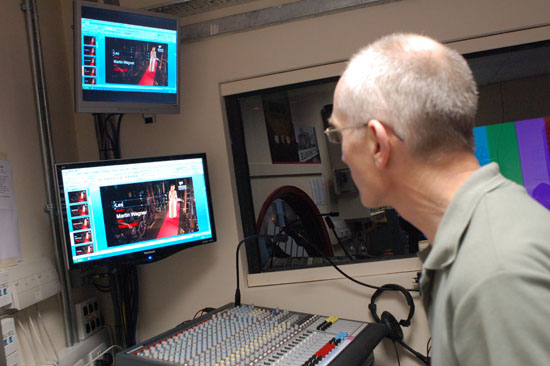 Duncan in charge of the slides Duncan in charge of the slides"Cineramacana" began in 1996, when Jean-Pierre Gutzeit from Berlin brought one 70mm reel of "Porgy and Bess" and asked Bill if it could be shown sometime during the festival. Two years later "Cineramacana" on Sunday morning at 10 was born, when the audience is treated to a 2 hour-plus program of odd reels, trailers and much more. Basically, everything that doesn't fit into regular feature film programming. Often each clip is introduced by the person who brought it along while the audience listens intently. Cineramacana remains one of the most popular attractions of the weekend. It is a huge task for the projection staff to "knit" everything together, for multiple format changes, microphones, slides, sound and so on. Mostly everything goes according to plan, but every once in a while small problems crop up, and the presenter - very often myself - has to ad lib some "fascinating details" about widescreen. |
|
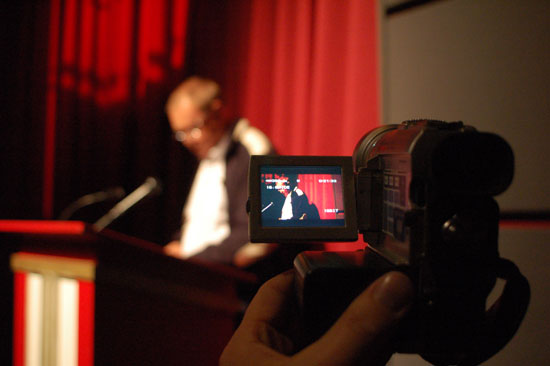 Bob Jessopp introducing "This is New Zealand", and being filmed
- ups, did I say that? - I mean TAPED in "UltraVision 70". Bob Jessopp introducing "This is New Zealand", and being filmed
- ups, did I say that? - I mean TAPED in "UltraVision 70".This year was no different, except we had FAR too much material, which meant we had to start even earlier at 9 in the morning. And believe it or not, A LOT of people turn up at that hour to see films! The audience is incredibly dedicated. The special treat this time was a brand new 35mm print of an original 3-screen, World's Fair movie originally produced for the 1970 EXPO at Osaka, Japan, "This is New Zealand", introduced by Bob Jessopp, who had flown in from New Zealand. The short was shown together with two other New Zealand EXPO films ("C'mon to New Zealand" (1969) and "This Is Expo" (1970)), and the whole program lasted an hour. "This is New Zealand" had excellent color and a dynamic 5.1 soundtrack. |
|
The Cinerama / 70mm Film Title Quiz |
|
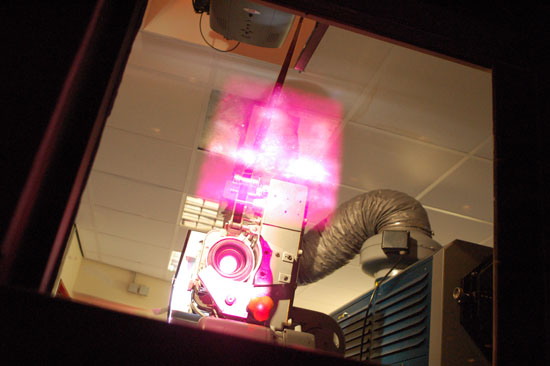 Baker projector showing pink films Baker projector showing pink filmsFor Cineramacana Sunday morning, Academy member Francois Carrin had prepared a quiz for the audience. Most CINERAMA & 70mm films were as popular in France as they were in the rest of the world, and France was one of the primary countries to screen these films. The QUIZ: Here you will find 10 French titles, followed by the literal translation from the French title used at the time of the original release. Try to figure out the original American/English titles. Good luck! HINT: this quiz includes two CINERAMA, five 70mm and three blowups. Here it is again for you to enjoy. The quiz is simple. 10 titles in French, and the literal translation. Your job is to guess what the original English title is. 1 – “La Grande Rencontre” - The Great Meeting (= what original film?) 2 – “Les Amours Enchantées” – The Enchanted Loves 3 – “L’Arbre de Vie” – The Tree of Life 4 – “La Reine du Colorado” – The Queen of Colorado 5 – “Le Voyage Inoubliable” – The Unforgettable Trip 6 – “Les Cavaliers Rouges” – The Red Riders 7 – “Sur la Piste de la Grande Caravane” - Along the Trail of the Great Caravan 8 – “La Mélodie du Bonheur” – The Melody of Happiness 9 – “Piège de Crystal” – Crystal Trap 10 – “58 Minutes pour vivre” – 58 Minutes to Live At the end of this page, you can read the correct answers. No PEEKING! |
|
The Curve vs. the Flat Screen |
|
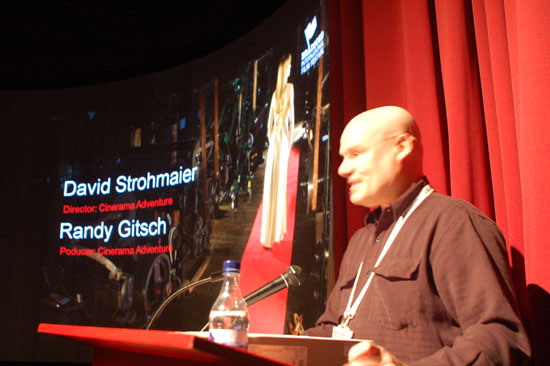 Randy giving a speech about 70mm short films. Randy giving a speech about 70mm short films.Magic unfolded right before our eyes Sunday morning, as the flat screen and 5 speakers were hoisted up into the ceiling. Most of the Cineramacana material this Sunday morning had been shown on the flat screen, but when Randy Gitsch and Dave Strohmaier introduced two 70mm short films, they were to be shown on the curved screen. Randy introduced the films by saying that it was next to impossible to find ANY material about the films, which prompted him to write a short lecture about short film motion picture history in general. I had the honor to introduce a UK 70mm premiere: "Tanakh Bibelen al-Quran" filmed in M.C.S.-70, which is Norwegian director Ole Mads Sirks Vevle's latest movie, and his first in 70mm. In less than 5 minutes of running time, he has filmed all pages of these 3 religious books. As the film screens, the pages are whizzing by rapidly with a custom score created in Stockholm. A very controversial film, which some liked a lot and others didn't. Personally, I like everything in 70mm. |
Your "Widescreen Weekend Report" is very good,
Thomas. I think if I'd never been to Bradford or a WSW before, and read your
piece, it would compel me to attend. Thanks again. Randy Gitsch |
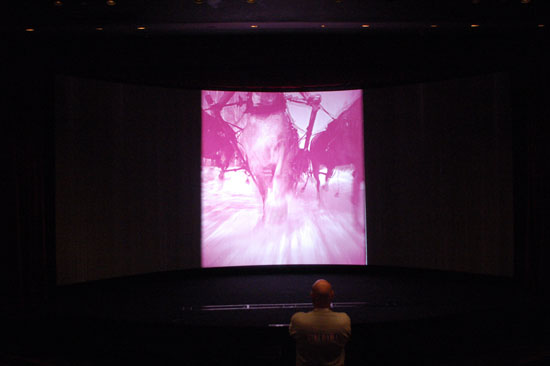 B-panel B-panelAt the end of Cineramacana the audience is traditionally invited on stage to be part of the "Audience on Stage" picture. It is also a rare opportunity to examine the strip louvered screen at close range. The audience is reminded of the delicate nature of the louvred Cinerama screen and are asked not to touch it. Very unlike prince Charles, (or was it prince Philip?), who visited the cinema and was also invited on stage. When he saw the louvres he simply used both hands to make a hole to see what was behind - to the horror of the projection staff who saw their screen being ruined! Oh yes, almost forgot, while I prepared to take a picture of all people attending, standing on stage, Paul "wrangled" them into position on that stage. Has become a tradition to split duties between us. Now you may download a copy from the web site. |
|
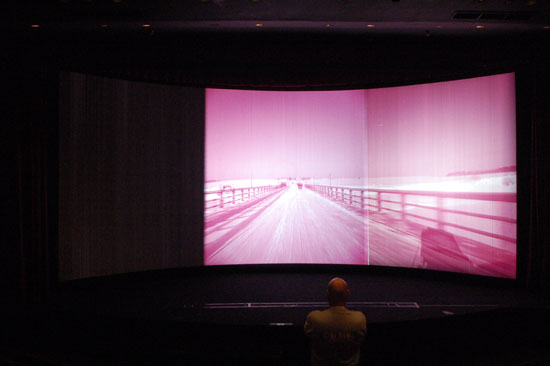 B-panel + C-panel B-panel + C-panelThe previous day, a mini-Cineramacana had been hosted by "The Dynamic Cinerama Duo" Randy Gitsch and Dave Strohmaier, close friends of the festival and frequent guests. Their special treat this year was an 18min 3-strip excerpt from the first half of "Cinerama's Russian Adventure" filmed in Kinopanorama. Probably the only existing print and recently saved by David, the "Indiana Jones of Cinerama"; who found it decaying in a container literally minutes from ending it's existence by being spray painted into an artist's mobile at an art exhibition. |
|
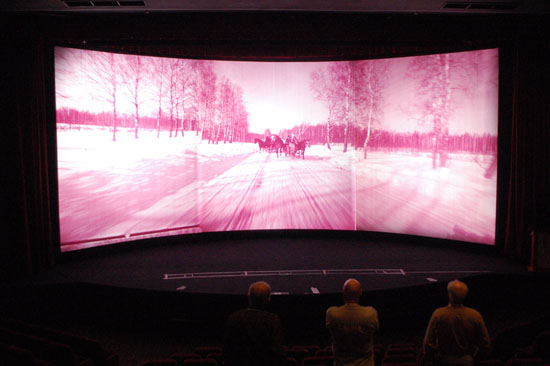 A + B + C panels = 3-strip Kinopanorama. Note that Able projector is set a bit higher. Frameline is visible for this test. A + B + C panels = 3-strip Kinopanorama. Note that Able projector is set a bit higher. Frameline is visible for this test.I love seeing films on the Cinerama curve. It's so amazing to see curved images - it might not always be correct, but all the same - it looks stunning. The long-going "conflict" between the purists and the enthusiasts is whether to show a particular film on the curve, or on the flat, screen. The purists are probably right about it when they say, “Where Eagles Dare”, as an example, should be shown on the flat screen, because it was not filmed with a curved screen in mind. I personally feel, however, that a film like that has a lot more impact on the curve. I know all the shortcomings, there is horizon sag, serious image cropping and other things wrong, but I don't mind them too much. The difference between home and cinema is the BIG difference. Images in cinemas should be BIG, and they ARE big on the curve. The curve is what it is all about and one reason people are flying in from the other side of the planet. If I want to see it in the "correct fashion" I can watch it on DVD. I'd probably not go and see it in a cinema on a flat screen. I prefer Pictureville's curve. Unimpressive flat screens are everywhere for the purist to enjoy. |
|
“Faubourg 36” |
|
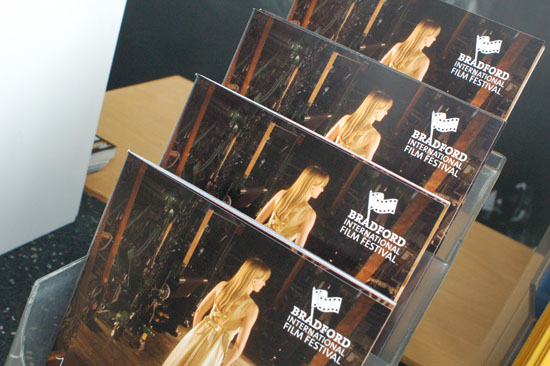 BIFF logo of 2009. The Golden Lady BIFF logo of 2009. The Golden Lady This year I also looked forward to seeing the new French film “Faubourg 36”, directed by Christophe Barratier, who made the charming “Les Choristes” in 2004. Mainly because it is a French musical - well, sort of - and obviously because it is “in 70mm”. This film is the first “blow-up” in many years and only 70mm print of this film. The 70mm print was very colorful and I rather liked the movie. I will see it again when it opens in Copenhagen later in June and I guess, buy the Blu-ray. The music is quite enjoyable, and leading lady, Nora Arnezeder, can really sing so I get the Goosebumps. The 70mm print was made by Jean-Rene Faillot’s Arane Laboratories in Paris, and I must say the quality was excellent and a really sharp 70mm blow-up. (Arane labs also made the 2002 restored 70mm prints of "Play Time".) The museum had gone the extra length, and had the film translated “on the fly” by staffer Deb Singleton, who was in the audience with a 3000 page PowerPoint translation. Prepared over a period of several weeks by Symon, she advanced the video-projected subtitles during the entire film, and she got a huge round of applause after the film. |
|
“Becket” |
|
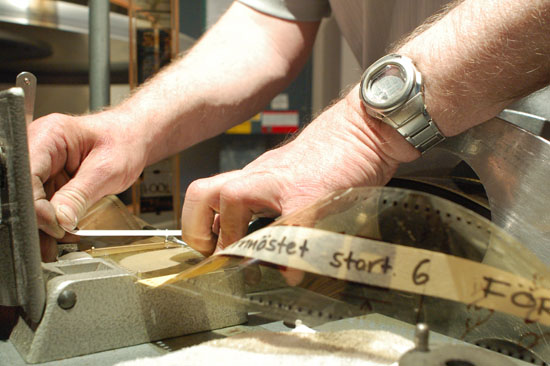 Splicing 70mm film together for the platter Splicing 70mm film together for the platterThe second film on my wish list had been “Becket”, on Sunday afternoon. I have never seen it, but have always been impressed by Burton and O’Toole. “Becket” is one of the very first 70mm blow ups, dating back to 1964 (In fact “The King and I” re-released in Grandeur 70, must have preceded it in 1961). A rare and very faded 70mm print generously loaned to us by the Kino Mir 70 cinema in the Czech Republic. Original English version with Czech subtitles. Solid performances from Peter O’Toole and Richard Burton. I also bought the DVD in the nearby HMV shop for 5 pounds, so I have a chance to see it in color at a later date. |
|
“Broadsword Calling Danny Boy” |
|
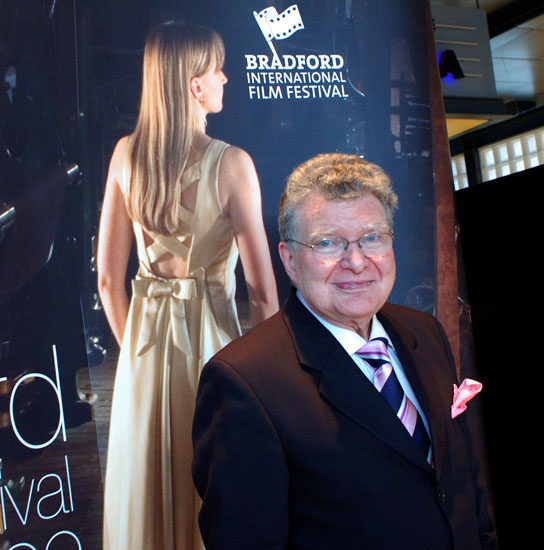 Darren Nesbitt was official Widescreen Weekend guest of honor Darren Nesbitt was official Widescreen Weekend guest of honorThis is code talk from one of the most beloved and classic films about World War II. "Where Eagles Dare" is from 1969 and this screening would be the 40th anniversary performance. I learned that anyone who says “Broadsword Calling Danny Boy”, is suffering from “Earnshaw disease” – named after the Head of Film at the museum, Tony Earnshaw, who is a big fan of the film. The famous “Broadsword” line is spoken by Richard Burton when he’s communicating with London in the film. A hugely popular film with a large fan following, which includes Steven Spielberg and Quentin Tarantino – who also wants to remake it. Only, WHY remake it? Tarantino ought to improve his own movies, before he messes up something else. On this Friday evening we showed a vintage 70mm print of “Where Eagles Dare” from the Swedish Film Archive in Stockholm. Our guest of honor was none other than the film's “Major von Hapen”, portrayed beautifully by English actor (1935) Mr. Derren Nesbitt. Mr. Nesbitt’s movie career started in the late 1950s and “W.E.D.” is probably his most beloved role – at least by me. He has been very active on the UK stage, and his ability to engage the audience during the “Screen Talk” was very obvious. The audience was in tears laughing when he told stories about the filming. One story was about Clint Eastwood, who asked the director, Brian G. Hutton, if he wasn’t supposed to reload his machine gun once in a while? The director calmly explained to him that “it didn’t matter” and “they will never notice in Arkansas”. Clint Eastwood also gave most of his lines to Richard Burton who loved to talk, which left Eastwood with the occasional grunts and “huhs?” throughout the movie. It was a very happy shoot, done almost exclusively on location in Austria. While being on location Mr. Nesbitt stayed in a small hotel of his own choice. |
|
 Darren Nesbitt rarely sees his own movies, but has recently seen "Eagles" with his son. Darren Nesbitt rarely sees his own movies, but has recently seen "Eagles" with his son.Brian G. Hutton was a gifted director, who made a fortune in real estate in Los Angeles from the money he earned as a director on very few films, including “Where Eagles Dare” and “Kelly’s Heroes”. Mr. Hutton largely left the movie business after “Kelly’s Heroes” because MGM re-cut it, to his own disapproval. Never before have the audience laughed so much – Mr. Nesbitt is a true entertainer. Even Head of Film, Tony Earnshaw, had to give up and declare Nesbitt for the most well dressed man he has ever interviewed, and by far the most fun Screen Talk he has done during his 10 years at the museum. |
|
Cinema Retro |
|
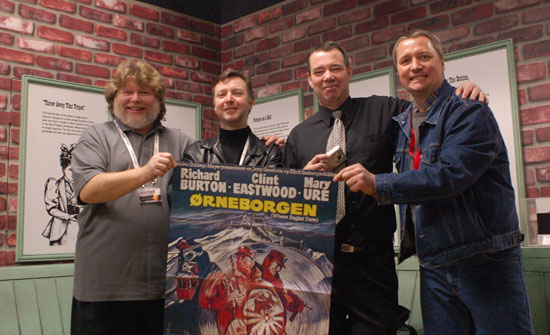 Lee
Pfeiffer and Dave Worrall
(right) having a ball and promoting the "Where Eagles Dare" - Cinema Retro ‘Movie Classics’ Special Lee
Pfeiffer and Dave Worrall
(right) having a ball and promoting the "Where Eagles Dare" - Cinema Retro ‘Movie Classics’ SpecialThe “WED” screening was sponsored and introduced by Dave Worral and Lee Phiffer of "Cinema Retro" – an advert-free film magazine about movies of the 1960s and 70s. Enthusiastically published three times a year, the magazine has 3000 subscribers and a growing web site with 9000 daily hits. Their love for the two decades is obvious. As Lee said, he recently met with composer John Barry (who lives in Oyster Bay, NY – birthplace of Cinerama), and they agreed that 1969 really was a vintage movie year for the baby boomers, with such timeless classics as “Midnight Cowboy”, “Where Eagles Dare” and “On her Majesty’s Secret Service” being premiered. “Where Eagles Dare” screening was sold out and it got enthusiastic applause when it was over. A hugely entertaining film, although it lost some of its spectacle being shown on the flat screen, and not on the curve. |
"Where Eagles Dare" - Cinema Retro ‘Movie Classics’ Special "Where Eagles Dare" - 40th Anniversary 1969 - 2009 Thanks Thomas - a brilliant report...looking forward to next year already! Lee Pfeiffer Editor-in-Chief Cinema Retro magazine Great report Thomas. Dave Worrall Cinema Retro magazine |
Digital Cinerama "out of one hole" |
|
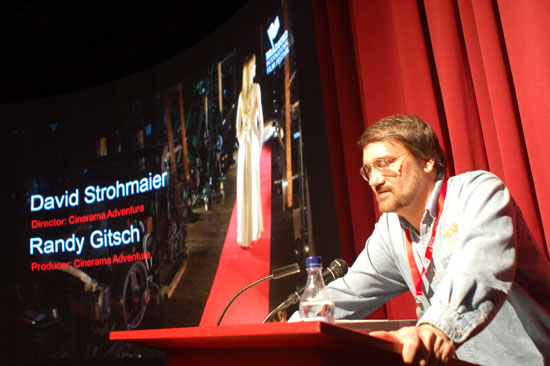 Cinerama changed the world in 1952 by introducing audiences to widescreen and stereo sound. We honored that history by showing the latest version of "How The West Was Won" in state-of-the-art digital. Earlier in 2008 I had learned from David Strohmaier that "West" was available for booking in a digital (d-cinema) version, and cinemas around the world could now show it to a whole new audience with digital projectors – but configured, theoretically, for a typical flat screen. "How The West Was Won" is an audience favorite. It has been shown 11 times during Widescreen Weekend in 2009, 2007, 2006, 2005, 2002, 2001, 2000, 1999, 1997 and 1996 (twice). Thanks to George Feltenstein, senior vice-president of catalog at Warner Home Video, we had “West” and I was curious just how it would look on an actual Cinerama screen. We all were. Projected from a single digital source, rather than classic 3-strip, it did sound like Mike Todd’s original wish: "Cinerama out of one hole". Having seen the film several times in Cinerama, I was pleasantly surprised. Although it was cropped severely on both side and top/bottom it looked reasonably good. (The cropping was necessary, it seemed, to make the image actually fill the screen). |
|
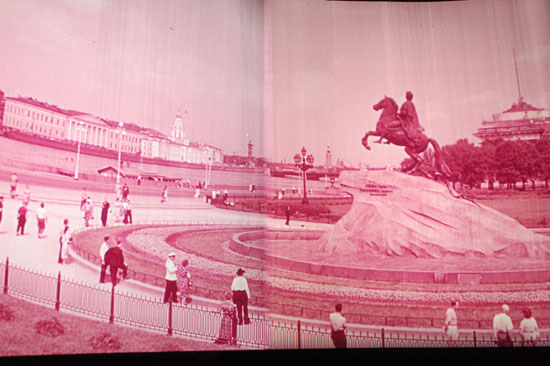 Note the difference between panels. The picture is jumping until the skilled Pictureville projectionists adjust the difference. Note the difference between panels. The picture is jumping until the skilled Pictureville projectionists adjust the difference.The problem is always to project a flat rectangular 2,79:1 format on a deeply curved screen and make it look good without cropping the image too much. That is simply not possible due to the laws of physics and geometry. Pictureville’s deeply curved Cinerama screen is one of its kind, and the cropping problem is unique to screens like that. On almost all other screens, the “film” will look spectacular. If the digital file had been “smileboxed” a bit (a process where the home viewer can have a chance to see an interpretation of the film as as it might look if it were being projected on a deeply curved Cinerama screen), it probably would have worked a little better, I suppose. The soundtrack was a new 5.1 mix, which pales somewhat in comparison with the original 7 track mix (5 discrete screen channels and left/right effects track). I felt there was no real low end “boom” to the 5.1 sound in this version. But in the end it was a tremendous experience to see a Cinerama film without too much distraction of the infamous “join-lines” of 3-panel projection. For most people, two vertical lines dividing the image up into three parts is as distracting as distractions come in a cinema. But for Cinerama fans, THAT pair of lines have always been a source of great enjoyment and an essential part of seeing Cinerama. For the first time, they were almost gone – erased – vanished from the film. The only giveaway was an occasional kind of "morphing" from panel to panel, revealing that “something was there”. David Strohmaier and Randy Gitsch introduced the film and delighted the audience with the announcement, that Image Entertainment is very close to finalizing a deal to launch "This is Cinerama" and "Windjammer" on DVD and Blu-ray. The release will include Smilebox versions of both. Keep fingers crossed - and your toes. |
|
Ultra Panavision 70 |
|
 New 70mm print of "Khartoum" is shipped in films cans like this. New 70mm print of "Khartoum" is shipped in films cans like this.Recently, MGM struck a new 70mm print of Basil Dearden’s “Khartoum”, starring Charlton Heston, who died in 2008. Projecting “Khartoum” in Pictureville presented the projectionists with a series of challenges. “Khartoum” is photographed in Ultra Panavision 70, a process which hasn’t been used in nearly 45 years, or even projected regularly. It requires a special set of lenses which have to be adapted and adjusted especially for each cinema. It is a custom set-up from cinema to cinema. Usually a “flat” Todd-AO 70mm image has an aspect ratio of 2,21:1, (width/height relations). When you look at a Todd-AO 65mm camera negative, the image appears normal. A basketball is round and a square is a square. It is different with Ultra Panavision 70, which means 65mm photography with a special lens. There is an added 25% horizontal squeeze and an ultimate screen aspect ratio of something like 2,79:1. A specific kind of optical distortion is introduced on the 65mm negative. Objects appear thin or taller, due to the 25% horizontal compression on the 65mm negative. If viewed by the naked eye, a basketball on the negative now appears oval, and a rectangle appears like a square. This is because of the non-linear type of photographic lens which was used to film the action. If the film is projected au naturel, objects will also appear thin or taller on the screen. To project Ultra Panavision 70 properly, a special lens is needed to de-squeeze, (or magnify horizontally), the image to correct proportions. No normal screens can accommodate such a wide 70mm image, however. In order not to “spill” film image on the side curtains in the cinema, it is necessary to reduce the overall image size on the screen with a longer focal length lens. The longer the focal length, the smaller the image. The final result may be not as tall an image, but is definitely w-i-d-e-r. |
|
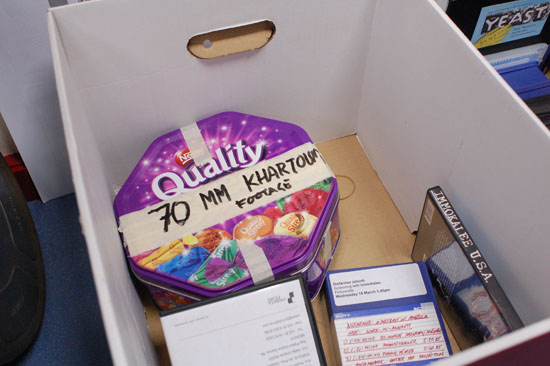 Something you don't see very often, an unusual "Khartoum" 70mm storage can. Something you don't see very often, an unusual "Khartoum" 70mm storage can.A few weeks before the Widescreen Weekend, Joe Dunton, a friend of Pictureville and camera wizard of JDC Scope lenses, visited the cinema and Duncan McGregor asked him he could help out with an Ultra Panavision 70mm projection lens. Intrigued by this task, Joe found a lens on e-bay, bought it and had it sent to Pictureville. Unfortunately it didn’t arrive on time, and it spent the weekend in FedEx’s office in Leeds. As a finale to the story, I saw FedEx’s van parked outside the museum Monday morning – lens arriving just a day after it was needed. |
|
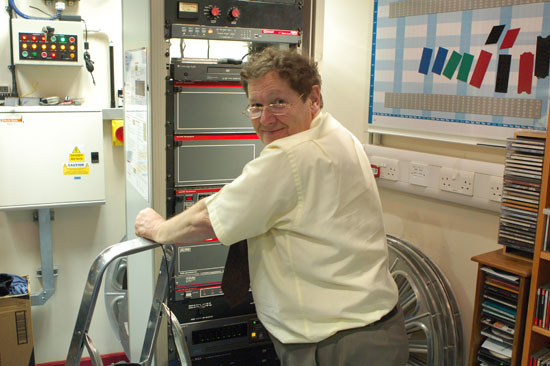 Dion working with the sound rack. Dion working with the sound rack.Dion Hanson, saved the day by attaching the Panavision Steinhal de-anamorphic attachment lens to a 50 year old vintage Philips T-Kipatagon lens with the correct focal length. In the end “Khartoum" was shown correctly, slightly letterboxed, on the curved Cinerama screen – in Ultra Panavision 70. Although the image was a bit “washed out” and contrast wasn’t the best on the left side of the screen, it worked very fine. The new 70mm print came directly from an engagement in Berlin, and as a surprise, the intermission came about 5 minutes too soon. For some reason, the intermission had somehow been put into the print in the wrong place. However, Tony Cutts remedied the problem after the film was shown and put it back where it belongs. What happened in Berlin? Did an esteemed festival like the Berlinale cut the intermission? Why? |
11.04.2009 I read your Bradford report and it was fantastic by the way, you are getting better at this all the time! The Berlinale certainly did show the same wrong intermission and I would not know why they wanted to move it by just a few minutes. I suspect the mistake was made somewhere else. But then you never know... Best Oliver Klohs |
Introductions |
|
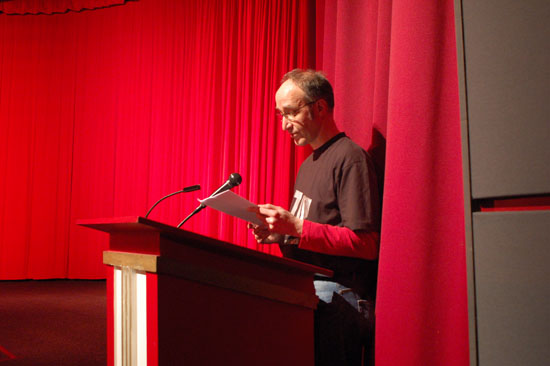 Wolfram Hannemann from Stuttgart, Germany introducing "West Side Story" in Super Panavision 70. Wolfram Hannemann from Stuttgart, Germany introducing "West Side Story" in Super Panavision 70.Introductions of the films is almost a tradition that came out of nowhere. It just happened. Over the years it has gotten more and more organized. Tony Sloman has been enormously helpful providing occasional introductions for many years. This year however, he was unavailable because he was lecturing on a cruise ship. The policy this year was to ensure that every feature film had some form of introduction. Festival regulars saved the day by preparing some appropriate introductions which served as a "making of" before each film. Here's a rundown of all titles, with links to relevant introductions "The King and I", "The Bible...in the beginning" & "West Side Story" - Wolfram Hannemann "This is Cinerama" & "How the West Was Won" - Dave Strohmaier "Concorde" and "Bridge to Space" and Randy Gitsch "Taming of the Shrew" & "Becket" - Tony Earnshaw "Faubourg 36" - Duncan McGregor "Where Eagles Dare" - Lee Pfeiffer and Dave Worral "This is New Zealand" - Bob Jessopp "Carousel", "Year of the Dragon" & "Electric Horseman" - Bill Lawrence "Khartoum" - Sheldon Hall |
|
Blow ups |
|
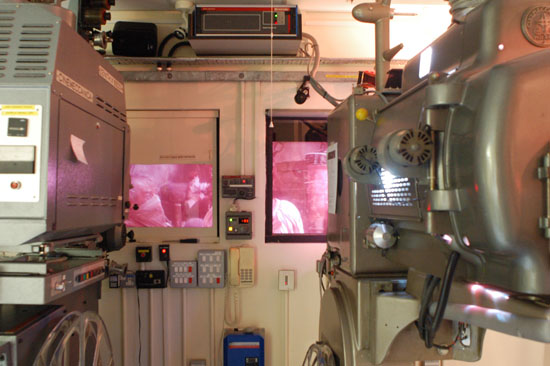 Projection room romance - pink film on screen. Projection room romance - pink film on screen.Recognizing the importance of 70mm history, not only do we show the films photographed in large format, but we try to show original 70mm prints of some of the extremely popular 70mm blow-ups from the 1980s. This year was no different when we presented “Year of the Dragon” (1985) and “The Electric Horseman” (1979). Image quality was staggering in both prints and a real pleasure to see, helped along by the German quality ISCO 85mm lens in the projector. As a testament to quality, "Dragon" was printed in it's original 2,39:1 aspect ratio on the 70mm print, securing the full original image to be seen on the screen. In fact the projectionists left the top masking in for 35mm CinemaScope. So the overall image was actually no bigger for a 70mm print as it fit within the normal 35mm Scope ratio. But the benefit of the 70mm blow up was: better color, sharpness, contrast and brightness thanks to the LARGE FORMAT. Bigger IS better! |
|
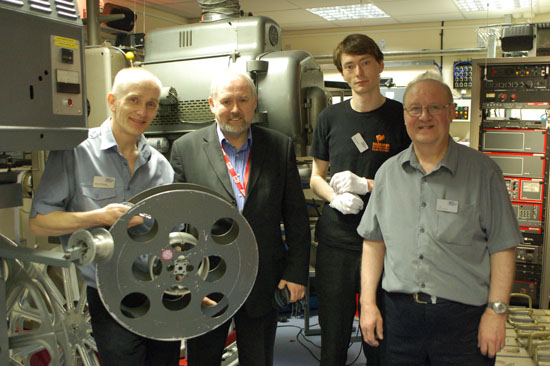 Duncan McGregor, Bill Lawrence, Symon Culpan and Tony Cutts. Duncan McGregor, Bill Lawrence, Symon Culpan and Tony Cutts.“Year of the Dragon” was filmed in JDC Scope by Pictureville's friend Alex Thomson and the image was equally as sharp, only “Dragon” was “in full color” thanks to the low-fade print stock developed in the early 1980s. Don’t think I have seen the film before, but it showed Mickey Rourke in top form. I remember seeing “The Electric Horseman” when it came out in 1979, and wasn’t really excited about it then – I had been all of 16. Now, 30 years later it was a much better experience to see. A slightly faded 70mm print from the years before the "low fade" stocks, but not too many scratches. As I said, the blow up quality was very, very good, and the projection lens enhanced to the image. |
|
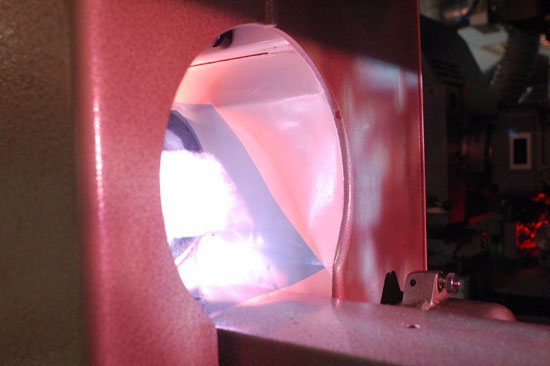 The blue filter in front of the DP70 projector. The blue filter in front of the DP70 projector.Oh by the way, Duncan, the chief projectionist, was experimenting with blue filters in front of the projection lens to compensate a bit for the missing colors of several films, including "The Taming of the Shrew". I saw only parts of the film, and it didn't look good with the filter. The theory is that it will add back some of the blue colors to an essentially "red" film. In this case all contrast was lost, and the image looked totally flat. I feel the problem is that the blue filter might add something, but it also takes away the white "colors" in the film. I prefer a faded film in the "official 70mm vintage color" of the 1960s - pink, red or brown, please! |
|
What else…. |
|
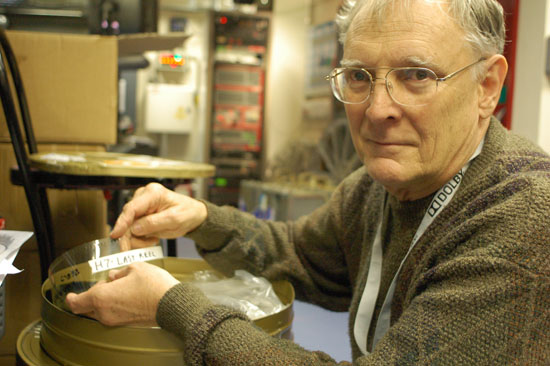 The master proof reader himself, Paul Rayton from Hollywood, California taking a look at the new "Khartoum" 70mm print The master proof reader himself, Paul Rayton from Hollywood, California taking a look at the new "Khartoum" 70mm printI didn’t see all the films at the Festival. I had to cut a few titles to get something to eat and stretch my legs. One film I didn’t see was “The Bible…in the beginning” Saturday afternoon. I had seen it recently - the new 70mm print - in Karlsruhe 6 months earlier. But I saw them setting it up for the performance. The attention to detail from the projection staff is staggering. “The Bible” was shown properly with the original blue Dimension-150 Curvulon lens, a lens that “paints” a perfect focused 70mm image on the huge curve. The lens was donated 10 years ago by Dr. Richard Vetter, the original designer of the Dimension-150 process. Nor did I see the 35mm restoration of "Carousel" Sunday afternoon – I’m sorry to miss it, but I simply have to get something substantial to eat once a day. I hope to be able to see it some other time. I understood from several that the new print looked spectacular. Bill Lawrence, who is an incurable romantic like me, came out of the cinema with tears in his eyes. It was very moving. Yes, I have got to see that sometime! I spent the late Sunday afternoon with Paul Rayton, my Hollywood "twin", and official in70mm.com proof reader (do you really believe I master the English language this well?), at the local restaurant “Omar Khan”, for a curry before “Khartoum”. That is one problem addressed by several guests: there is no time to eat between films. It would be nice to have more time. Other large format festivals arrange meals between films. Why not in Bradford? But my only complaint is really something different - ever since I can remember, the door to the toilet in the foyer needs oil badly - fix the bloody door hinges, please! |
|
The Cinerama / 70mm Film Titles Quiz Answers |
|
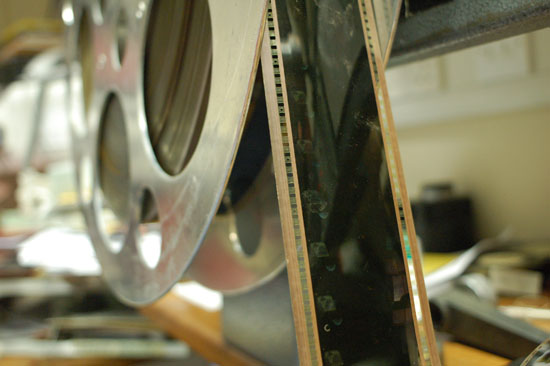 1 – “Windjammer” 1 – “Windjammer”2 – “The Wonderful World of the Brothers Grimm” 3 – “Raintree County” 4 – “The Unsinkable Molly Brown” 5 – “Mediterranean Holiday” 6 – “Old Shatterhand” 7 – “The Hallelujah Trail” 8 – “The Sound of Music” 9 – “Die Hard” 10 – “Die Hard II” |
|
The End of WSW 2009, but Widescreen Weekend will return |
|
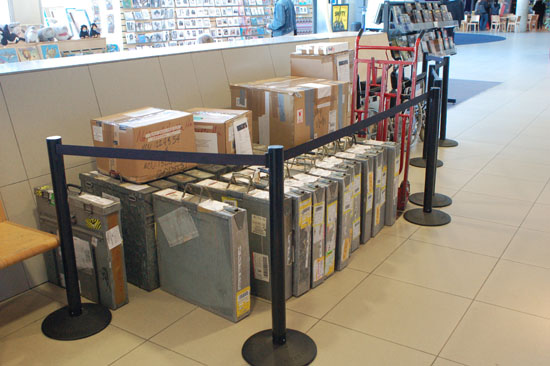 Another fine weekend behind us. Yet again did
those flashy large format logos grace both screens of the Pictureville cinema. For a few days, the 1960s had been back. Another fine weekend behind us. Yet again did
those flashy large format logos grace both screens of the Pictureville cinema. For a few days, the 1960s had been back.
Long forgotten trade names like CinemaScope 55, Super Panavision 70, Cinerama, Ultra Panavision 70, Kinopanorama, JDC Scope, Digital and MCS 70 - Superpanorama excited a primarily male audience. A nice and varied program of vintage and new prints, a collection of pink bores and vinegar wonders. Tune in for 2010 by subscribing to in70mm.com's free monthly newsletter, by Bill Lawrence. Just send him an e-mail and you will be added to the mailing list. If you have any interesting 70mm or Cinerama prints in your garage or refrigerator, please let me know. We are particularly interested in showing "The Wonderful World of the Brothers Grimm" in 3-strip Cinerama. See you there...... |
|
|
Go: back
- top -
back issues
- news index Updated 22-01-25 |
|
